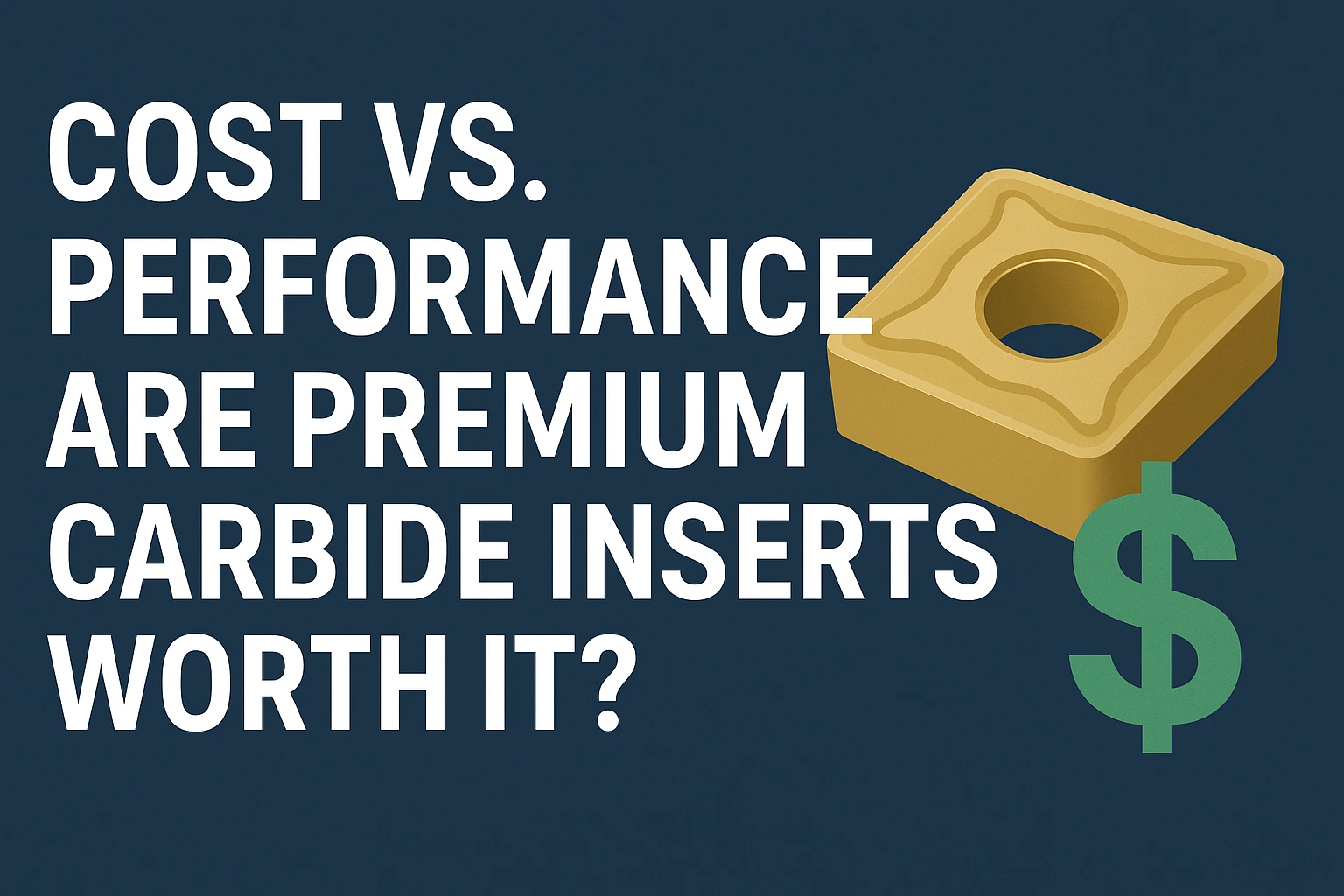Cost vs. Performance: Are Premium Carbide Inserts Worth It?
Often — but not always. The right choice depends on your part volume, material, machine uptime cost, and the machining challenge (stainless, cast iron, HRSA, etc.). This guide explains why premium carbide inserts can justify their price — and how to evaluate them using ISO insert nomenclature, cost-per-part math, and practical examples.

CNC shops, contract manufacturers, and in-house production teams constantly balance two pressures: reduce per-part cost and keep quality and uptime high. Carbide inserts are small components that directly affect cycle time, surface finish, scrap rates, and machine uptime — so the choice between a low-cost “commodity” insert and a premium, brand-grade insert can change a production line’s economics. Industry leaders (Sandvik, Kennametal, ISCAR) now sell tooling and services around cost per part because tooling decisions often affect total manufacturing cost far beyond the sticker price of an insert.
Introduction
How to evaluate cost vs performance
-
Define the true cost-per-part (machine hours, overhead, scrap, tool change downtime). Tool price is only part of the equation.
-
Match geometry & grade to the job (material, cut depth, feed rate). The best grade for stainless differs from the best grade for cast iron. Consider lifecycle costs: downtime for frequent insert changes, rejects due to out-of-spec parts, and secondary operations add up. Premium inserts may cost more per piece up-front but save on these costs.
-
Run controlled trials and compute savings using cost-per-part calculators or vendor programs before wide adoption. Vendors like Sandvik and Kennametal offer cost-per-part services and tools.
The technical side: what “premium” really means
Premium inserts typically differ from commodity inserts across these technical axes:
Substrate & microstructure (toughness vs hardness)
Premium grades use optimized carbide grain sizes and cobalt binder compositions to achieve a balance of fracture toughness (resists chipping) and hot hardness (resists wear at high cutting temperatures). Grade selection is material-specific.
Coating technology (PVD vs CVD vs uncoated)
- PVD (Physical Vapor Deposition) produces thin, dense coatings (typically 1–8 µm). PVD coatings are applied at lower temperatures (≈400–600°C), give sharp edges and improved adhesion for many finishing and stainless-steel applications. CVD (Chemical Vapor Deposition) produces thicker coatings, applied at higher temperatures (≈900–1000°C). CVD gives excellent high-temperature wear resistance, often preferred in high-speed steel or cast-iron machining where thermal barrier properties matter.
Plain-language analogy: Think of the coating as a weatherproof jacket: thin and fitted (PVD) for agility and precise cuts; thick and protective (CVD) for heavy, hot work. Choose the jacket to match the weather (material + cutting temperature).
Chipbreaker & geometry
Chipbreaker geometry controls chip formation and evacuation. Manufacturers design chipbreakers for finishing, medium cuts, or heavy roughing. Chipbreaker effectiveness is manufacturer-specific (not standardized by ISO), so grade/geometry matching is essential.
Edge preparation and tolerances
Premium inserts often have tighter tolerances (ground edges) and refined edge prep, improving repeatability, seating in toolholders, and surface finish—especially important for tight-tolerance parts. ISO includes tolerance classes in its code (more below)
Brand comparison (neutral, factual)
Major brands (Sandvik Coromant, Kennametal, ISCAR, Kyocera, Sumitomo, Mitsubishi, Seco) differ in:
- Grade portfolios (each has proprietary grades optimized for specific materials).
- Chipbreaker families (each vendor tunes geometry per material/application)
- Support & services (application engineering, cost-per-part programs, on-site support). Sandvik and Kennametal publicly promote cost-per-part and tool-management services.
Neutral takeaway: There isn’t a single “best” brand — there’s the best combination of grade, geometry, support and price for your part and process. Always test in your own shop and use vendor data as a starting point
Practical recommendations by application
- High-volume production (automotive parts): Invest in premium grades + wiper geometries to lower CPP via fewer changes and higher feed rates. Use vendor application trials. Aerospace (exotic alloys, titanium): Choose grades optimized for HRSA and use appropriate coolant strategy; premium PVD/CVD grades that resist chemical wear are typical choices.
- Die & mold (stainless, tough steels): Use PVD-coated fine-grain substrates with chipbreakers tuned for built-up edge resistance.
- General jobbing/low-volume: Commodity inserts may be cost-effective for one-off jobs; focus premium spend where consistent cycles, tight tolerances, or downtime cost justify it.
Short case example (illustrative, not vendor-specific)
- Shop A: 10,000 parts/year. Machine burden rate = ₹1,500/hr. Insert A (commodity) = ₹250 each; life = 500 parts. Insert B (premium) = ₹500 each; life = 2,500 parts.
- Commodity CPP_tooling = 250/500 = ₹0.50 per part. Premium CPP_tooling = 500/2500 = ₹0.20 per part. If premium also reduces cycle time or scrap, the CPP_total gains are larger — so premium wins despite higher sticker price. (Always run shop-specific math.
Conclusion — how to decide
- Use ISO 1832 to interpret geometry and tolerance (so you order the right insert).
- Don’t buy on sticker price alone — calculate cost-per-part including downtime, scrap, and machine burden. Use vendor cost-per-part tools or run a short A/B trial.
- For challenging materials (stainless, HRSA, hardened steels) or high-volume runs, premium inserts often pay back quickly. For low-volume or non-critical jobs, commodity inserts may be fine
Frequently Asked Questions
CNMG is an ISO/ANSI short code. C = 80° diamond shape, N = 0° clearance (negative/double-sided), M = tolerance class (medium/molded), G = type/cross-section. The following numbers (e.g., 120408) encode size, thickness and nose radius. Always cross-check with the vendor datasheet
Use grades and coatings designed to resist built-up edge and chemical wear — typically fine-grain substrates with PVD TiAlN/TiCN variants and chipbreakers optimized for stainless. Brands publish “turning-inserts-for-stainless” guides; test in your setup for the final pick.
Learn the first 7 positions of ISO 1832 (shape, clearance, tolerance, type, size, thickness, nose radius). Start by decoding shape and clearance (first two letters) — these tell you fit and whether the insert is double-sided. Use a vendor’s insert-identifier tool or chart for quick lookup.
PVD = thinner, cooler application (≈400–600°C), sharp edges, great for stainless & finishing. CVD = thicker, hotter application (≈900–1000°C), strong thermal barrier, often used in cast-iron and high-speed applications. Both have pros and cons — match by material and cutting speed.
CNC Tools Depot aggregates leading brands, supports ISO-code filtering, and provides technical product details so you can compare grades, chipbreakers and price quickly — a time-saving way to run trials and buy the best fit for your shop.



